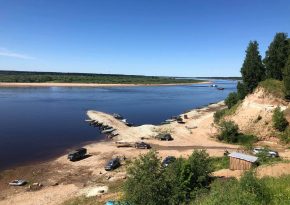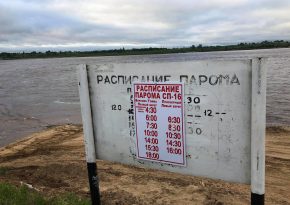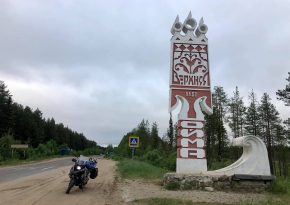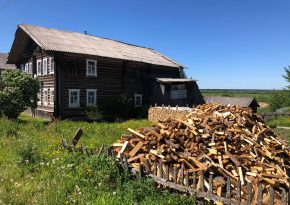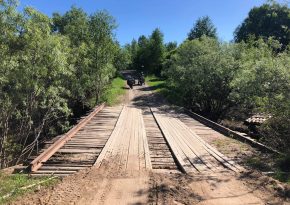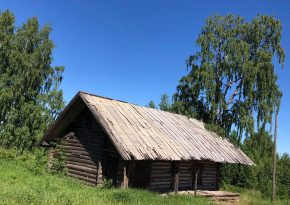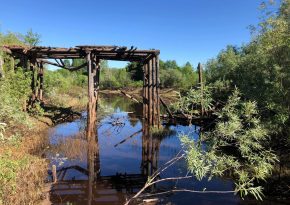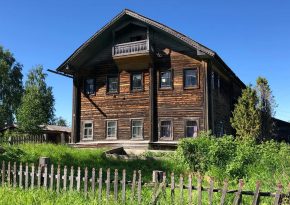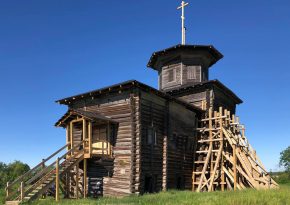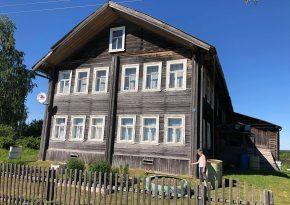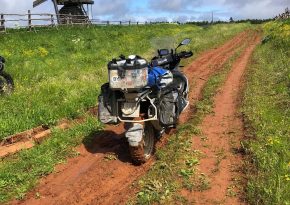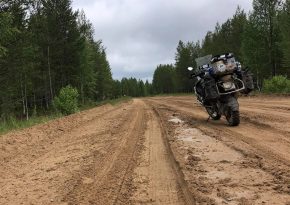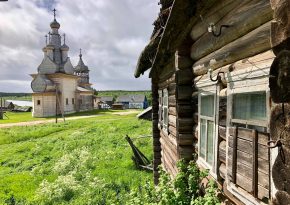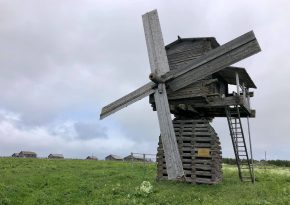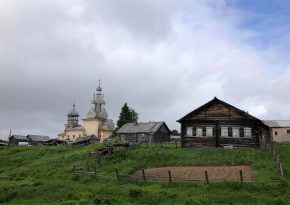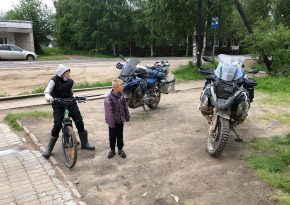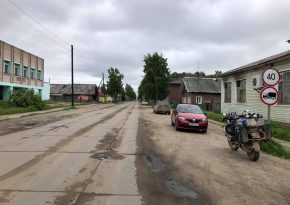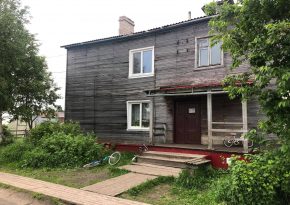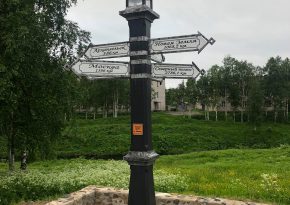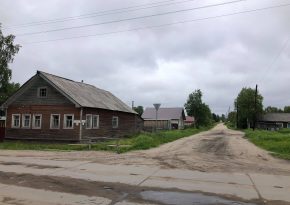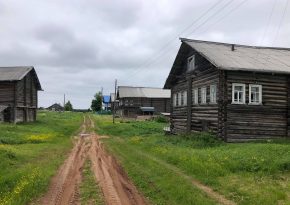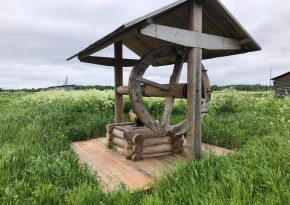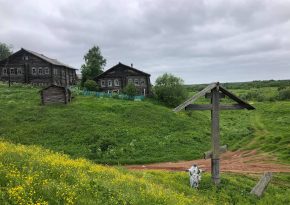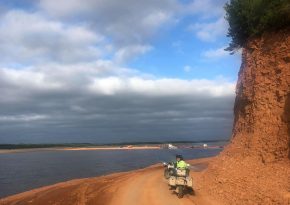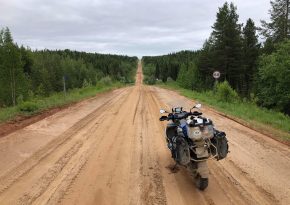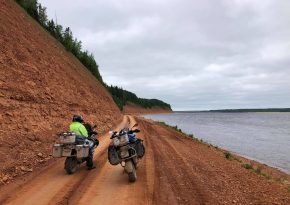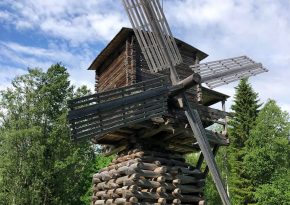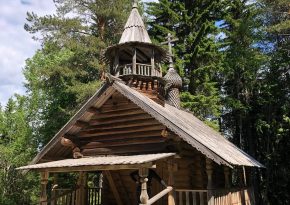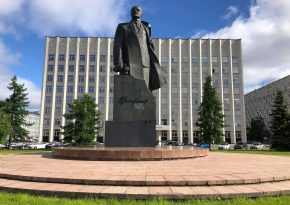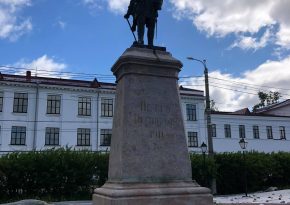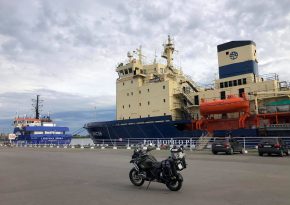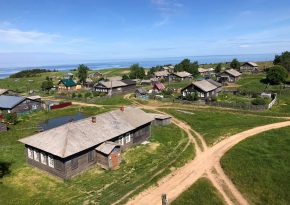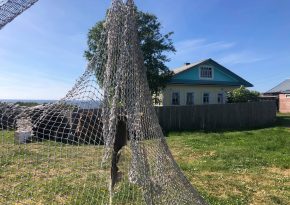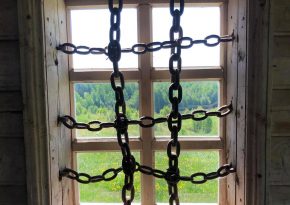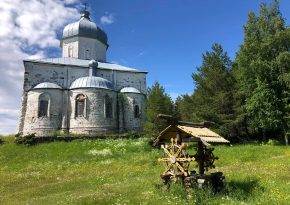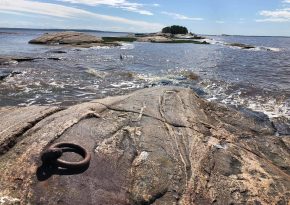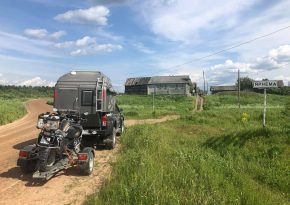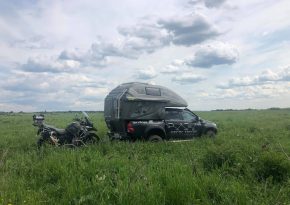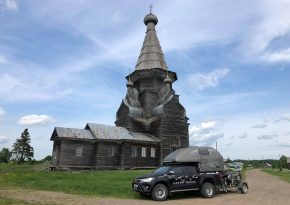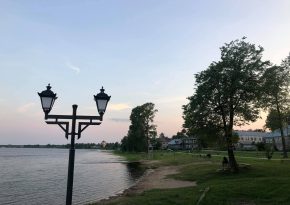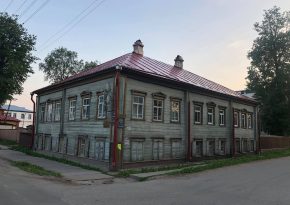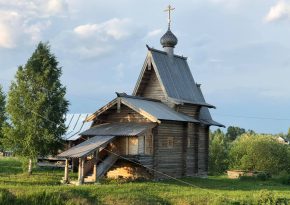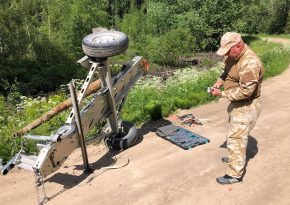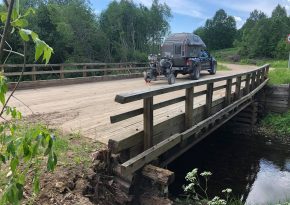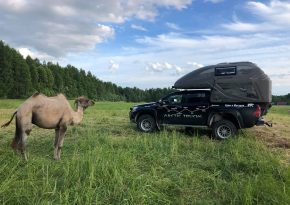To the White Sea on two wheels. Part 2.
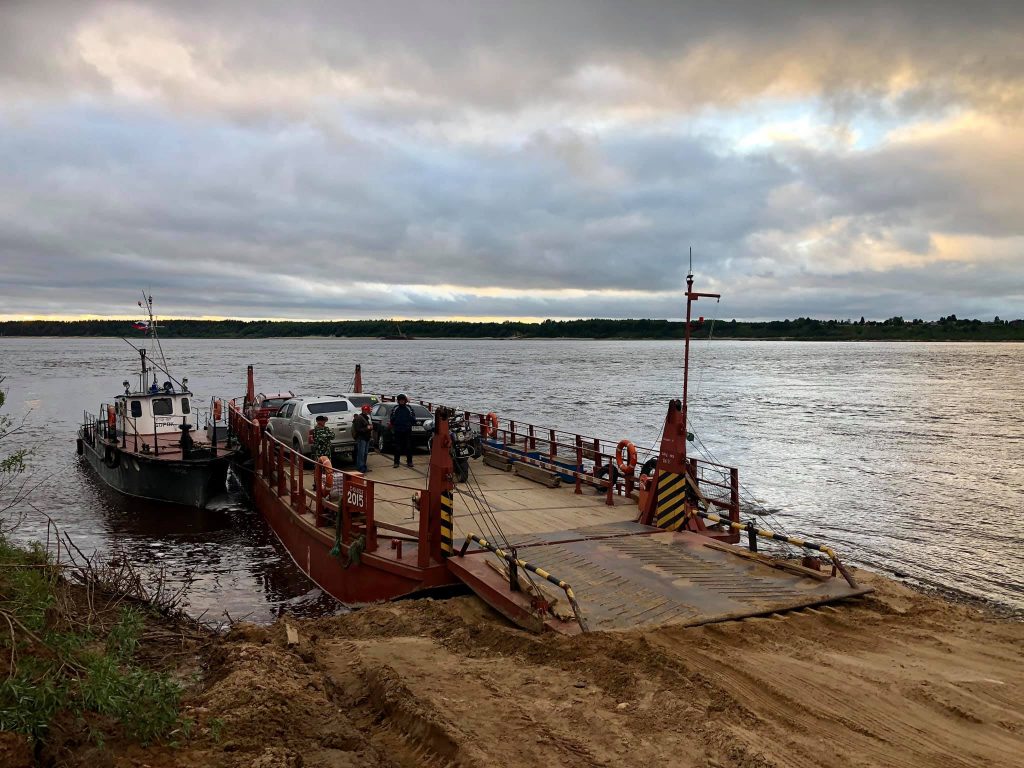

Kholmogory.
Now we have been travelling around the towns and villages of the Russian north and are still surprised by the beauty of its nature and the simplicity and kindness of the locals.
Life flows here not like in Moscow or other big cities.
Nobody is in a hurry, there is no fuss, no hustle and bustle. People easily make contact: to start a conversation it's enough to have a stop, say hello to the first person you meet and ask him or her a simple question "How are you?". Yesterday we rode along ground roads nearby the Northern Dvina and faced several villages with simple names: Voznesenskaya, Kuzminskaya, Alekseevskaya, Vasilevskaya…
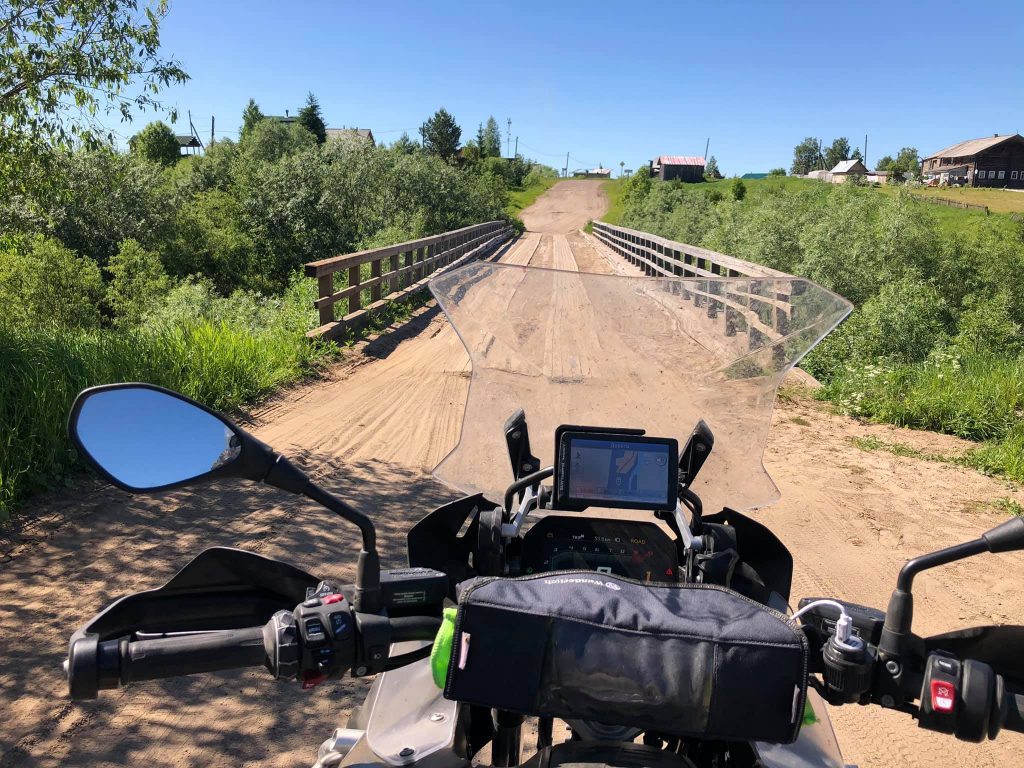
There are a lot of old, time-blackened houses built before the revolution or even in the XIX century. The log houses there are two-storeyed and quite big, usually with outbuildings and a bathhouse near them.
I stopped in front of one of the houses to take a photo. An elderly man came out, said hello, asked where we were from and began a small talk. Ten minutes later he invited us into the house and showed us all the rooms, including the attic and the utility space. He shared with us the story of this house, which had been built by his great-grandfather in 1906. In addition, he also told us how his grandfather had avoided dekulakization (the Bolsheviks' policy) in the 30s, and how then his father had kept the household during the difficult post-war time.
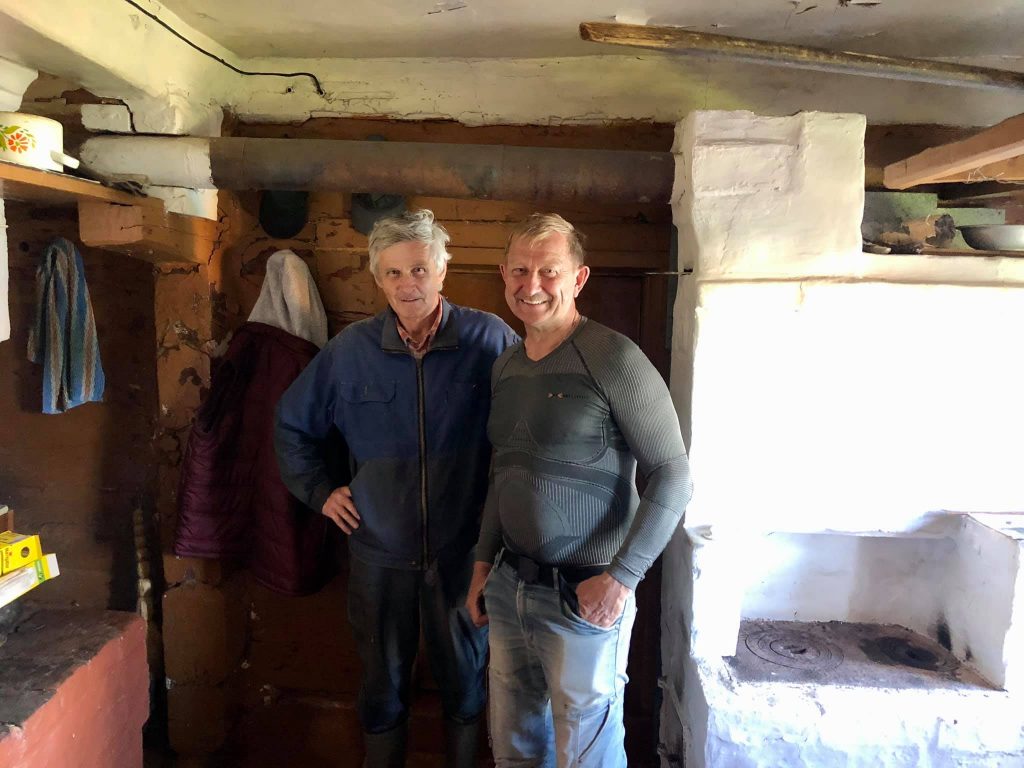
Unfortunately, there are many abandoned and dilapidated houses with boarded-up windows and yards overgrown with weeds. Young people are leaving their homeland for the cities, therefore, many villages are dying out.
And almost in every large village there is a dilapidated church. Wooden or stone churches, whose bell towers are without bells and domes without crosses, stand as monuments to the barbaric attitude of us and our ancestors to our own history and faith.
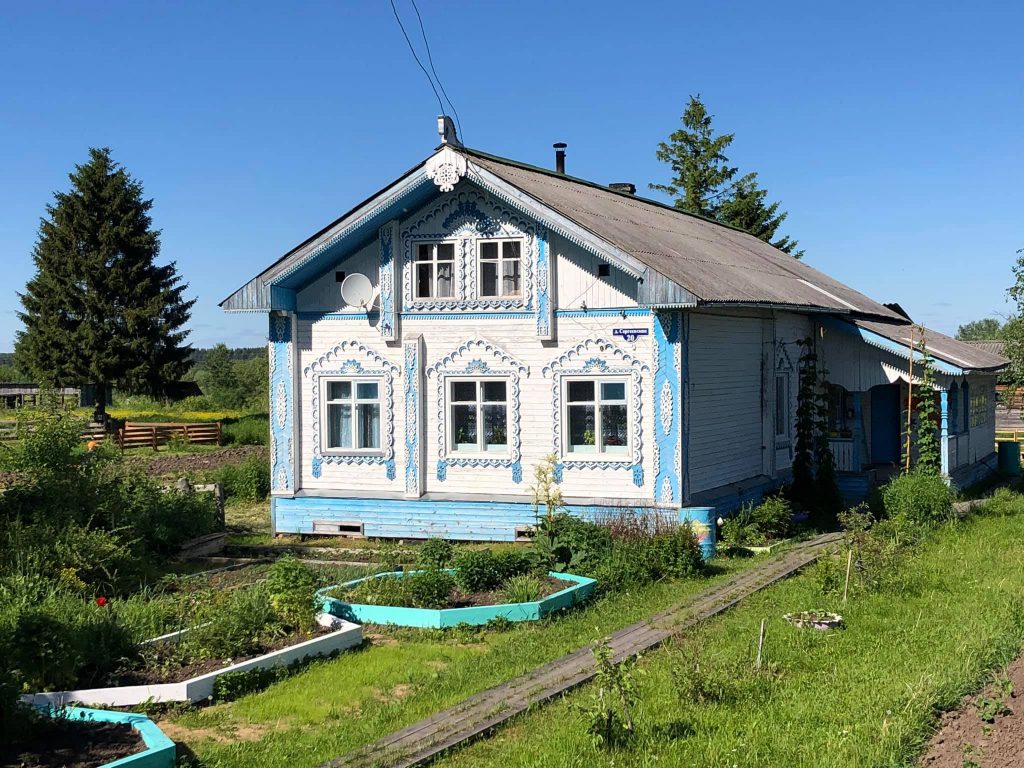
In an old historical village Kholmogory we stopped near the former bishop's cathedral, surrounded by scaffolding, blackened by time. While we were taking the pictures, the holy father Oleg came to us and gently asked us to remove our motorbikes from the territory of the temple.
We apologised, smiled and asked him to tell us the story of the village and the church. As a result, we went on a fascinating and very interesting two-hour-long excursion throughout the territory of the temple and were invited for a cup of tea. We have become friends and left with a blessing and kind parting words.
Pinega.
A ferry engineer was already lifting the entrance ramp with a hand winch when we reached the pier.
"Guys, you are lucky!", said the cashier, who came up to us. "The next voyage is only in two and a half hours. Get the tickets for 120 roubles".
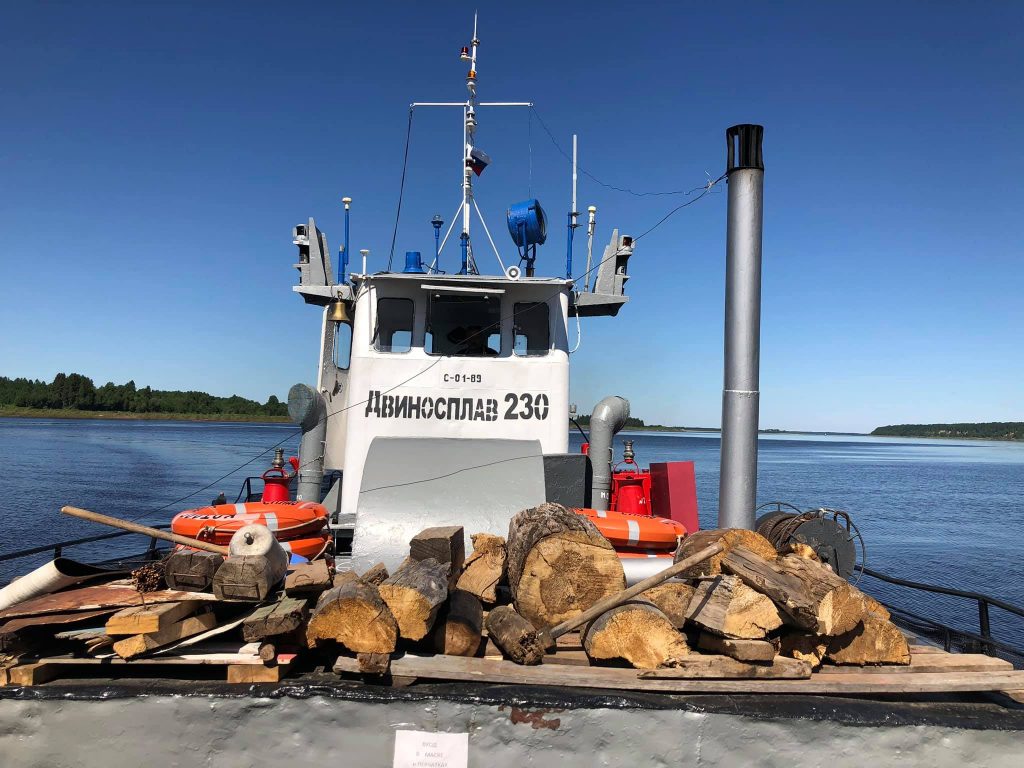
15 minutes later we were already on the opposite bank of the Northern Dvina and continued our journey north. Asphalt has ended on the other side and there are hundreds of kilometres of ground roads, sand, stones and dust altogether ahead. At least, it's good that there aren't many cars.
The road was good for our motorbikes. We kept going at an average speed of about 100 km/h. The suspension was working in enhanced mode, it swallowed all the bumps and pieces of gravel. And only the clouds of dust would hang behind for a long time.
We were riding along the bank of the Pinega river, which is an inflow of the Northern Dvina. The weather was gorgeous, the nature around was fine too. From time to time we faced small villages with houses blackened by time and fishing boats on the shore. The road followed the outline of the riverbed and went into the forest, leading to a steep pass with exposed marble rocks.
We stopped at the wooden signmark "waterfall". Here the path leads into the forest. We left the motorbikes by the road and went deeper into the taiga. There huge pines and three-hundred-year-old larches covered the sky with their treetops. 15 minutes later we heard the sound of water and… there it was! The stormy spring was bursting out of the rock and immediately disappearing somewhere between the rocks. That was fantastic!
Kimzha.
The weather became terrible. It rained all night, the wind broke tree branches, and the temperature dropped to +6°C only.
There appeared a lot of puddles on the road, which turned it into a mud-sand mess. And we had to ride more than two hundred kilometers today along it.

After Pinega, near which we stopped overnight, we had to overcome 150 km of deserted taiga without any communication cables and any signs of civilization in order to reach the village Kimzha, a unique place on the map of the Russian north. Kimzha is notable for being among the top of 25 most beautiful villages in Russia and for the fact it has been preserved so well that now it looks the same as it looked a hundred or even two hundred years ago. Can you imagine that almost all the houses in it were built in the 19th century and most of them are still in good condition? However, there are some abandoned log huts (izbas).
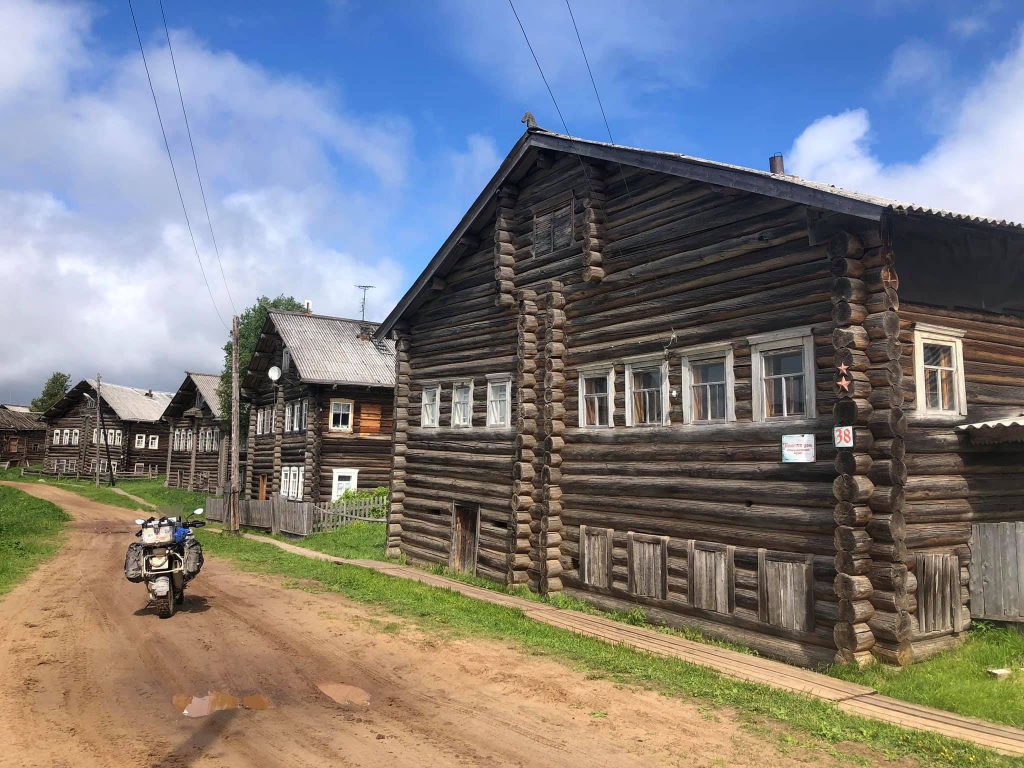
The amazing wooden Odigitria Church, which was built in 1763 and completely rebuilt a few years ago, impressed us with its extraordinary architecture. It was visible from afar and we went up to it. Near the temple at the shop there were three women in medical face masks (that was surprising to me). After taking a few photos, I rode up to them, greet them, but in response I heard just a request not to come close. We were speaking at a distance. It turned out that the locals were very scared of the coronavirus and this is not the first time when visitors are considered to be potentially dangerous in small villages because of this. Alas! That's all the bad influence of TV.

It is clear that an attempt to stay overnight here didn't make any success.
But despite these minor inconveniences, we are delighted at Kimzha! Indeed, it is one of the most remarkable places I've ever been. There we saw even preserved original windmills, which are also more than 150 years old!
The big six-walled log huts, blackened by time, with white curtains at the windows, were following us with a curious gaze while we were slowly riding along the streets washed out by rain and with wooden sidewalks laid.
That must be the genuine spirit of the Russian north!
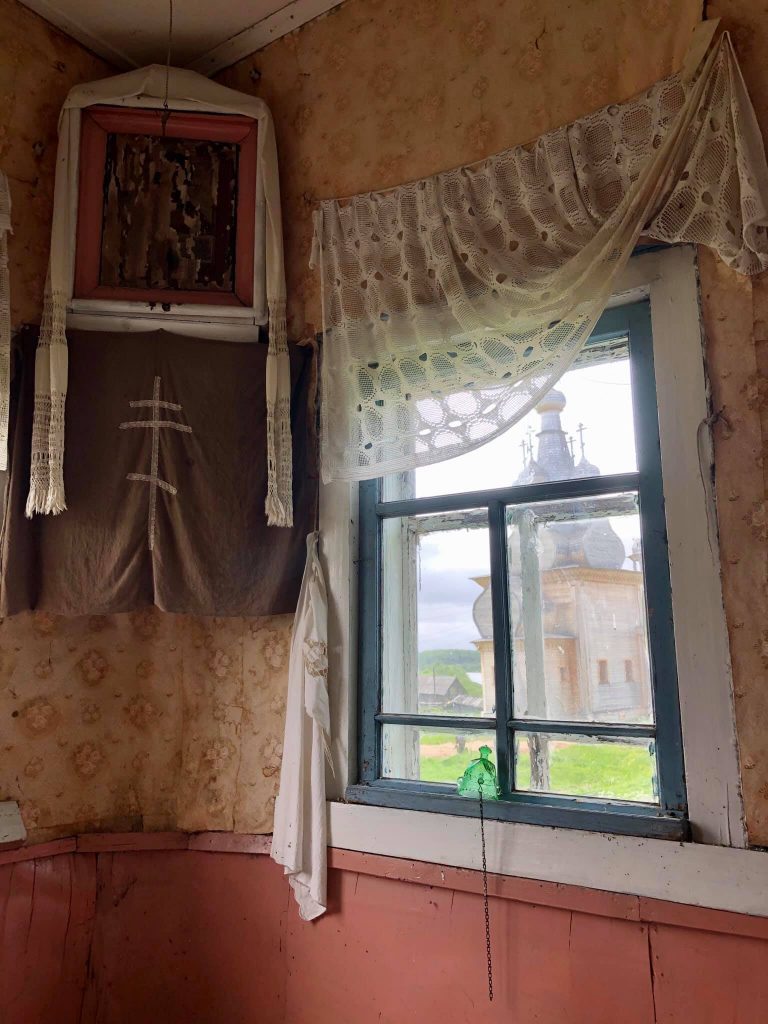
Mezen.
Roads in the north are slightly different from the definition of a road. Until 2008 there were no roads to the district centre Mezen at all. Only a winter road. Also people could reach it by the river and the White Sea to the Arkhangelsk direction. And the airplane used to fly in case of emergency.
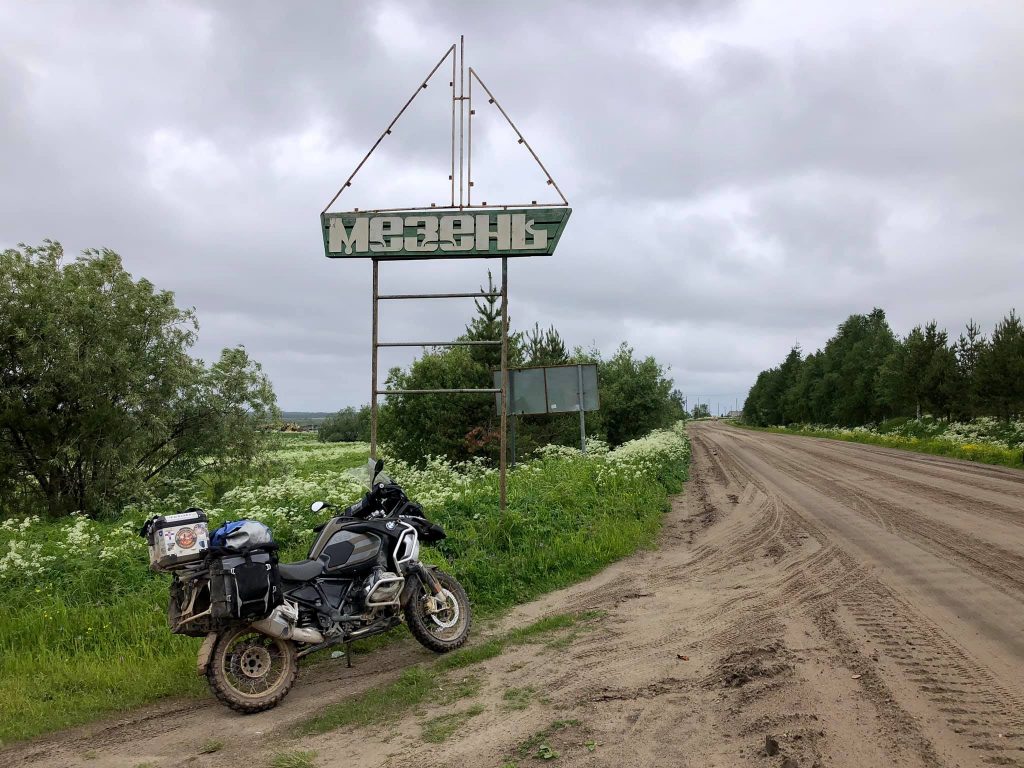
Mezen is the last big settlement in the north. There is no road further. During the times of Monarchy, it served as a place of exile and this is understandable. It was not possible to escape from here by land. Hundreds of kilometres of taiga around and the White Sea to the north.
The village is going through hard times right now. Although, in comparison with the 90s, everything is not so bad.
We rode along the central street, named Sovetskaya and paved with concrete slabs. It is stretched in a straight line through the entire village. There are mostly one-storey wooden and brick houses of different types, some are very shabby and blackened by time. Some of them have become shops with faded advertising banners on the facades. Along the street there are wooden sidewalks. Also there are very few people. Either the rain and cold locked them home, or the cursed coronavirus.

We went to the shop to buy groceries. While we were choosing what to buy, we started the conversation with the sellers, two women over 50 years old. A couple of minutes later, another visitor, a stout 45-year-old man joined the talk. They told us about the life of the people in the far north. There are actually a lot of problems and the main one is unemployment. One day large logging and fishing enterprises collapsed and private traders were forbidden to catch fish. So were the hunters. The border guards are strict, there is no way out to sea. Fish supervisors and gamekeepers are strict too. Fines for illegal fishing are large and so on.
I asked them how they made their living then.
The man answered evasively that they tried to make ends meet.
We negotiated overnight with the owner of this shop. He turned out to be a local "merchant", who owned a cafe and an inn in addition to the grocery shops. We settled for 2500 roubles for a bed, which was expensive, but there were no other options. Our accommodation included drunken men in the next room, a team of electrical network installers, which were on a business trip. One of them, whose name was Andrew too, broke into our room several times, sat on the bed and tried to tell us how he had been serving on a nuclear submarine in the late 80s. From his story I realised that he didn't like Americans and regretted not having fired all 16 missiles with nuclear warheads at the United States.
This is what a town on the edge of the world is like. :)
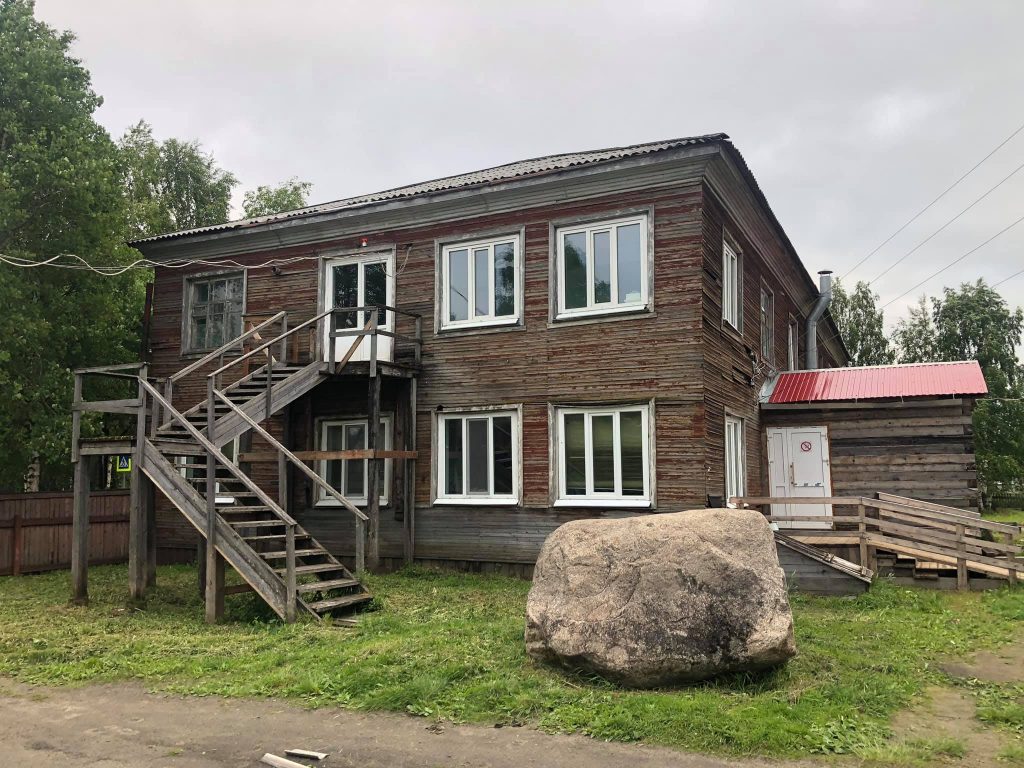
Kiltsa, Pogorelets.
It rained all night, the heavy drops pounded on the windowsill. I'm leaving Mezen with a feeling that I will hardly want to return to this town again.

The next point of our trip is village Kiltsa. As well as Kimzha, it is also included to the association of the 25 most beautiful villages in Russia.
We were riding along the right bank of the Mezen river and the village Kiltsa was located on the left bank. We took a turn into a small village Kozmogorodskoye, where we had intended to negotiate with someone from the locals to be transported to the opposite shore. We were riding slowly along the main street, looking at old houses, a well with a huge winch and a horse walking towards us. At one of the gates we saw a man, who was smoking a cigarette. We said hello and asked him if he could take us to Kiltsa.
— To Kiltsa? Of course, I can. But why would you go there?
— Well, the village is said to be very beautiful!
— Hmm… just an ordinary village, I think. Okay, go to the shore, I'll be right there.
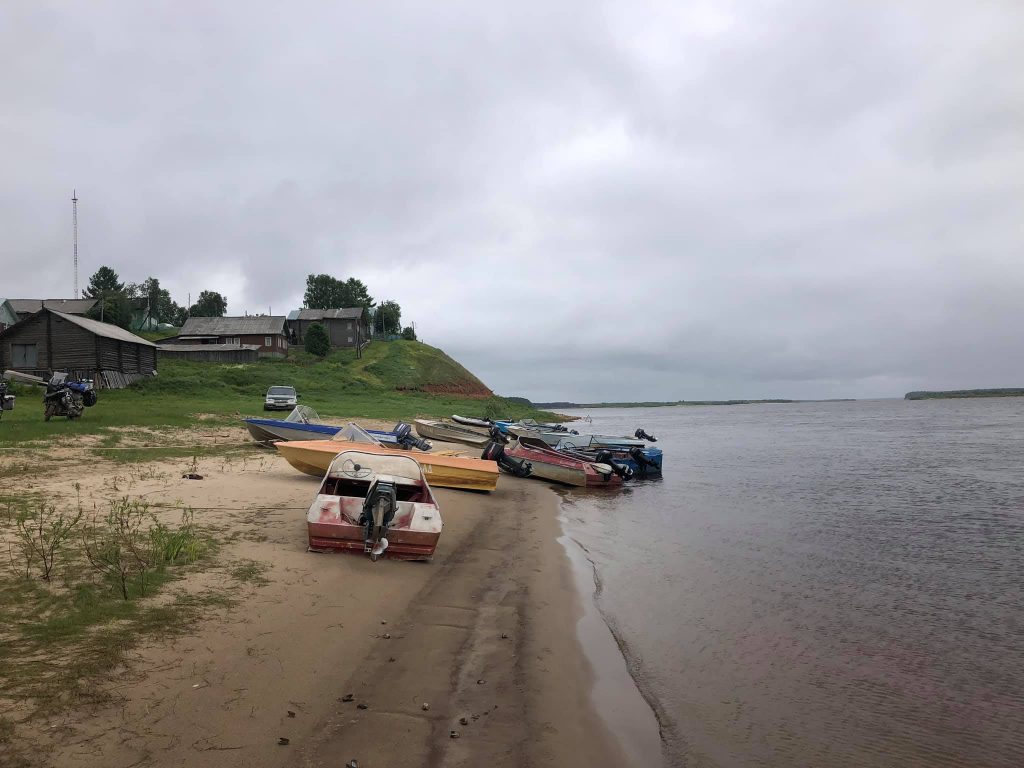
We followed the rain-washed road down to the river, where a dozen small boats of the Kazanka-type were docked with their noses in the sand. After having filled the tank with gasoline, Sergey (this is how our guide had introduced himself) pushed the boat away, started the engine and 15 minutes later we were already anchoring at the opposite shore.
Kiltsa greeted us with a huge votive cross. Next to it there was another small cross wrapped in towels and a crooked pillar that once had an icon in it.

We walked down the street. Sergey kindly agreed to be our guide. Moreover, he had once restored a couple of old log huts there as a carpenter. Kiltsa is certainly a unique village with a 400-year-old historical background. 90% of the houses in it were built more than 100 years ago. Some of them have got the signmark "Monument of architecture. Protected by the State". However, it is unclear whether anyone protects anything here.
Most of the houses are in good condition and all of them are different. They are big, two-storey or one-storey, with balconies, carved platbands and other decorations, with huge warehouses and barns.
Nevertheless, many houses require urgent repairs, since the lower facades have rotten, the foundations have sagged and the walls are askew. Sergey said that a house here could be bought for 50 thousand roubles. But it will be 20 or 30 times more expensive to restore it.
After a couple of hours we returned back, thanked Sergey and went further along the Mezen. After passing 14 km from Kozmogorodsky we reached another beautiful village called Pogorelets. It is even older than Kiltsa, it's 450 years old! There is a functioning church and two ancient mills on the top of the hill.
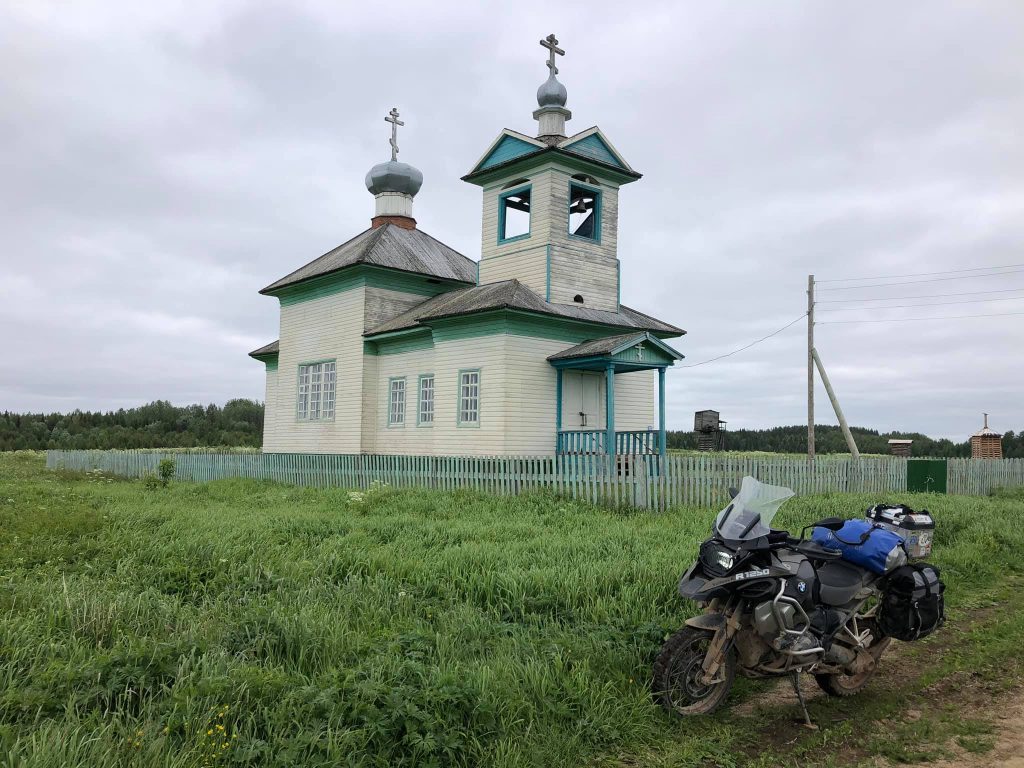
By the way, in the local dialect a hill on a high bank is called "UGOR". And "SHCHELYA" is a high cliff, which faces the river.
In Pogorelets most of the houses are also very old, built before the revolution. I wish I could stay here at least for a few days to breathe in the purest air, talk to the senior residents, go fishing with the men… But we have to go further along the sodden roads, further from civilization.
My journey is going on!
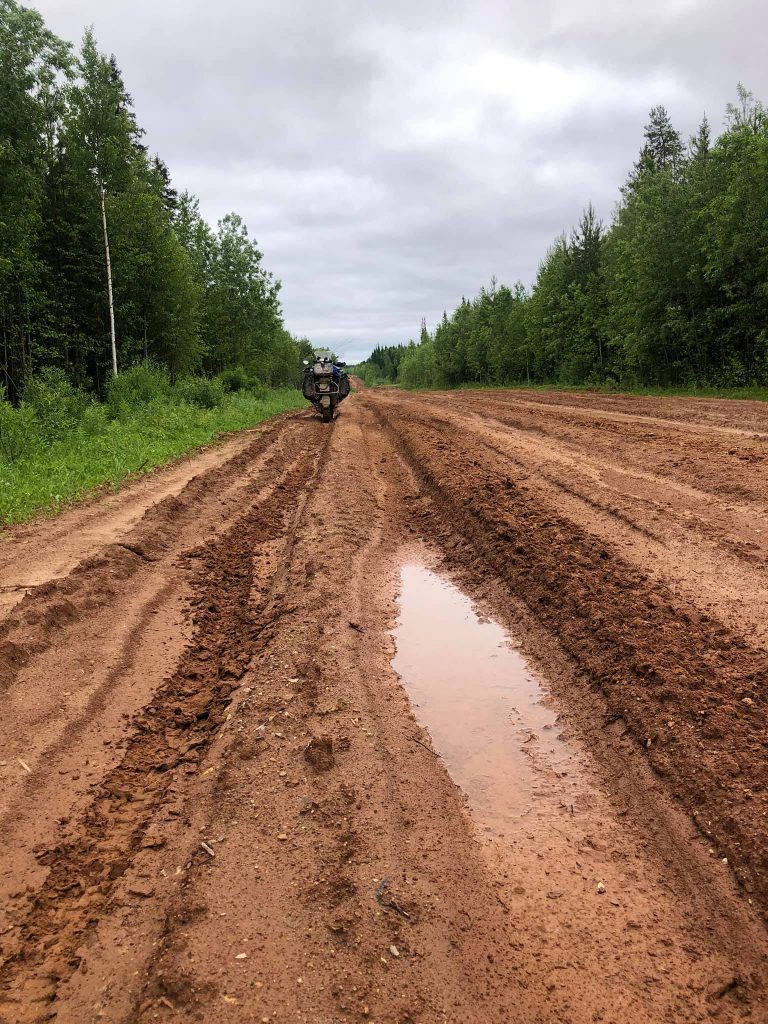
Arkhangelsk.
20 km from Arkhangelsk there is a unique place, named Malye Korely. It is a huge park with an area of 140 hectares. In its territory there are dozens of wooden buildings built from the 16th to the 19th century. They are temples, windmills, peasant houses, outbuildings, which were brought here from all over the region.
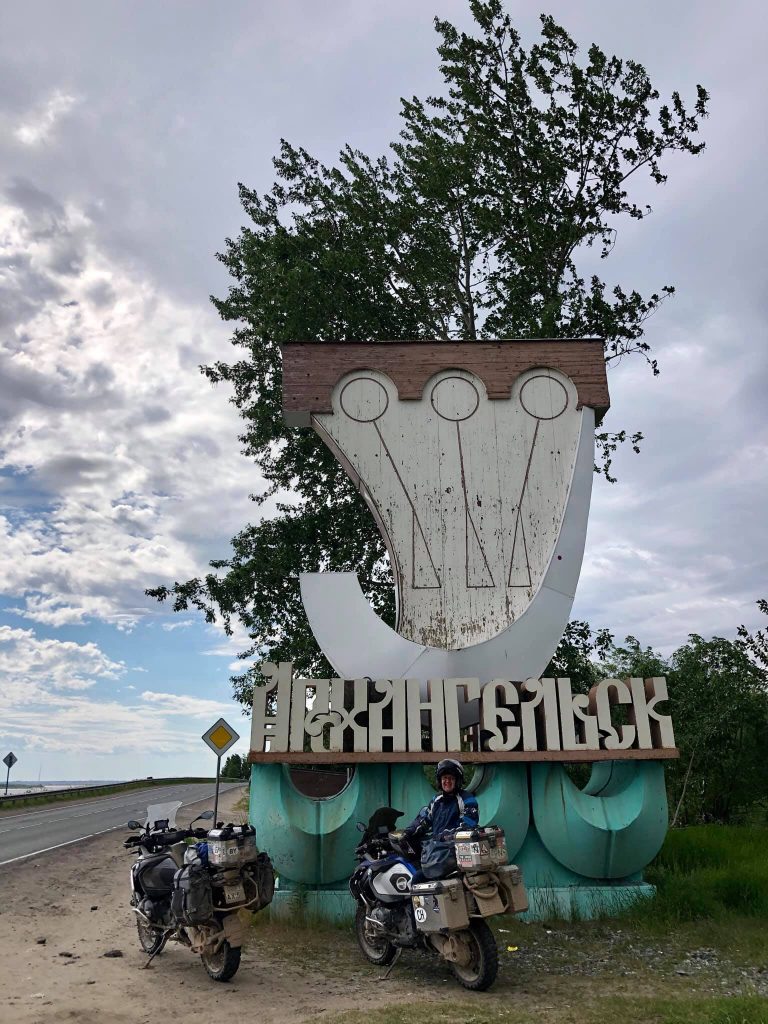
We ran upon it by chance while we were passing by and spotted a beautiful wooden church on the top of a high hill on the right. I saw similar parks (but much smaller) in Suzdal and not far from Irkutsk.
This was our first visit to Arkhangelsk, so we decided to take a guide and did not regret it! Sergey Yakovlev, a historian, photographer, journalist and just a professional guide took us on an excellent sightseeing tour of the city. Arkhangelsk is definitely worth visiting! There are a lot of attractions to see in it. This is a city, where the history of Russia is imprinted in every building!
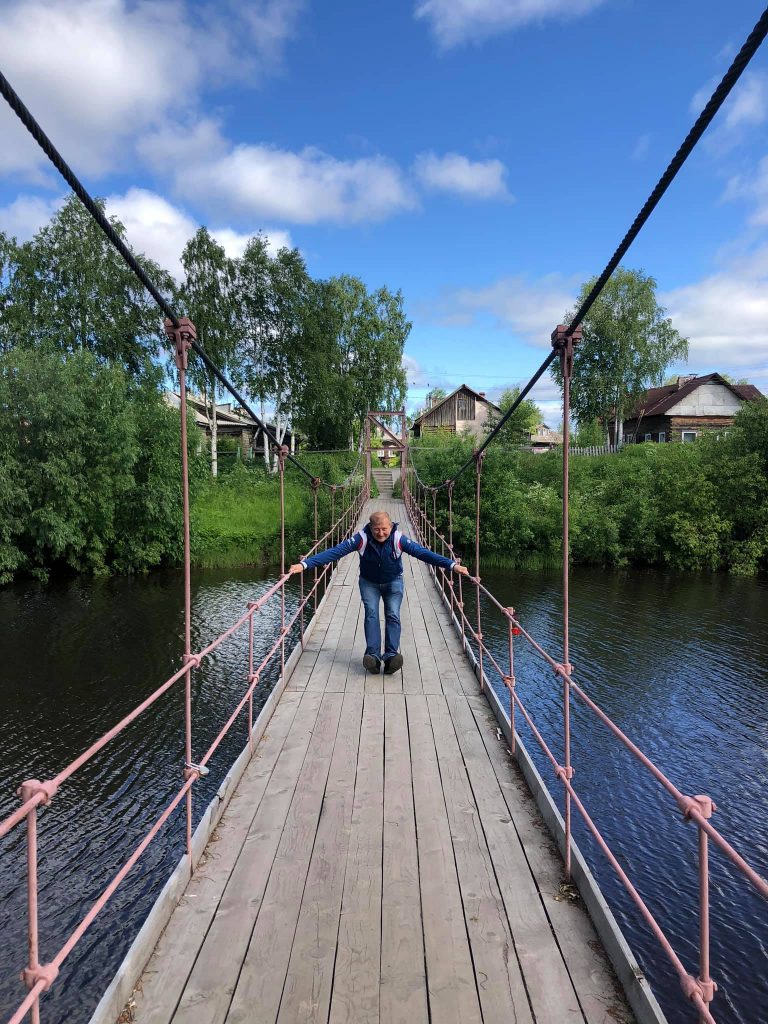
Unfortunately, the condition of streets, houses and numerous monuments and roads leaves a lot to be desired. Apparently, the sea waters, strong winds and the northern climate do their job unlike the authorities of this really wonderful town.

Severodvinsk.
"They won't let you go into Severodvinsk, the town is closed. There is an outbreak of coronavirus now and people are allowed there only by registration", that's what the administrator of the hotel in Arkhangelsk told us and what our guide repeated.
But we decided to take a chance, although there was little probability. And we almost lost any hope when we got into a long traffic jam in front of the traffic police post and a huge red poster "Entry to Severodvinsk is restricted." But a miracle has happened! While a traffic police officer in a medical face mask and gloves was checking the documents of another car, we carefully rode past him and five minutes later we were already rolling along the streets of the town!
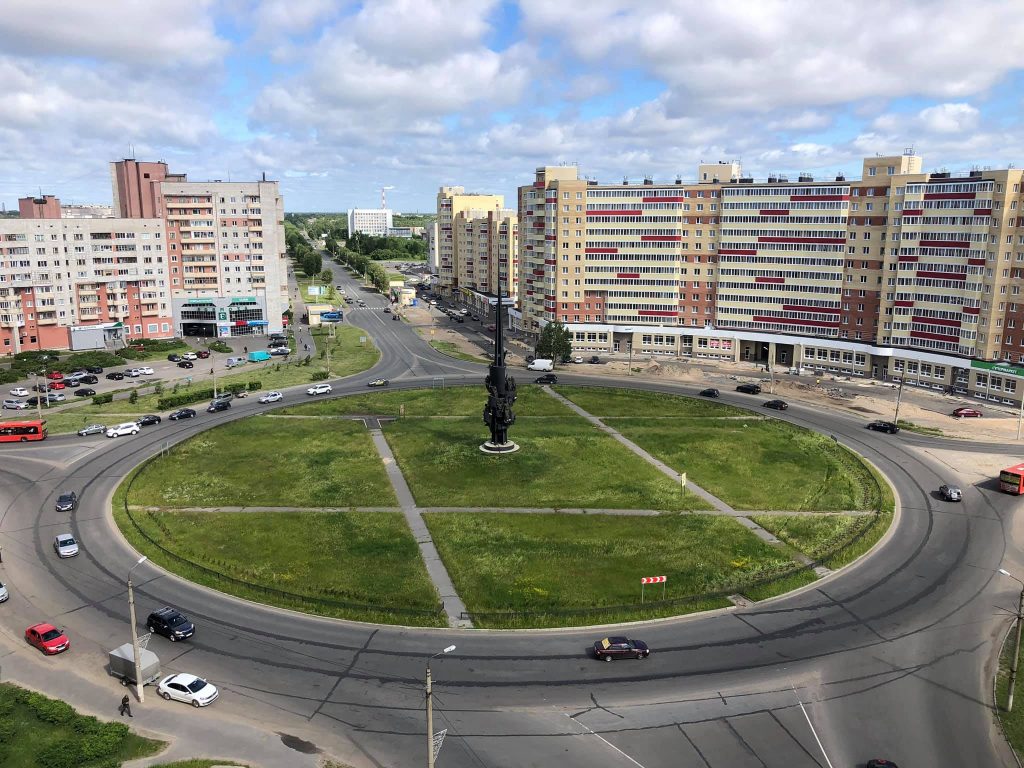
Severodvinsk made an impression of a more modern and well-groomed town than Arkhangelsk. The roads are flatter, the sidewalks are cleaner and the houses are less shabby.
We stopped at Jagry (it's a big island in the northern part of the town) and saw a long deserted sandy beach. The cool sea and the sandy spit reminded me of the beach in Jurmala. We rode a little by motorbikes along the water edge and reached the cape from which two Akula Project 941 submarines were visible. The largest nuclear submarines in the world were docked at the pier! Severodvinsk can be described as one huge shipbuilding and ship repairing cluster. Every third resident of the town works at one of these enterprises.
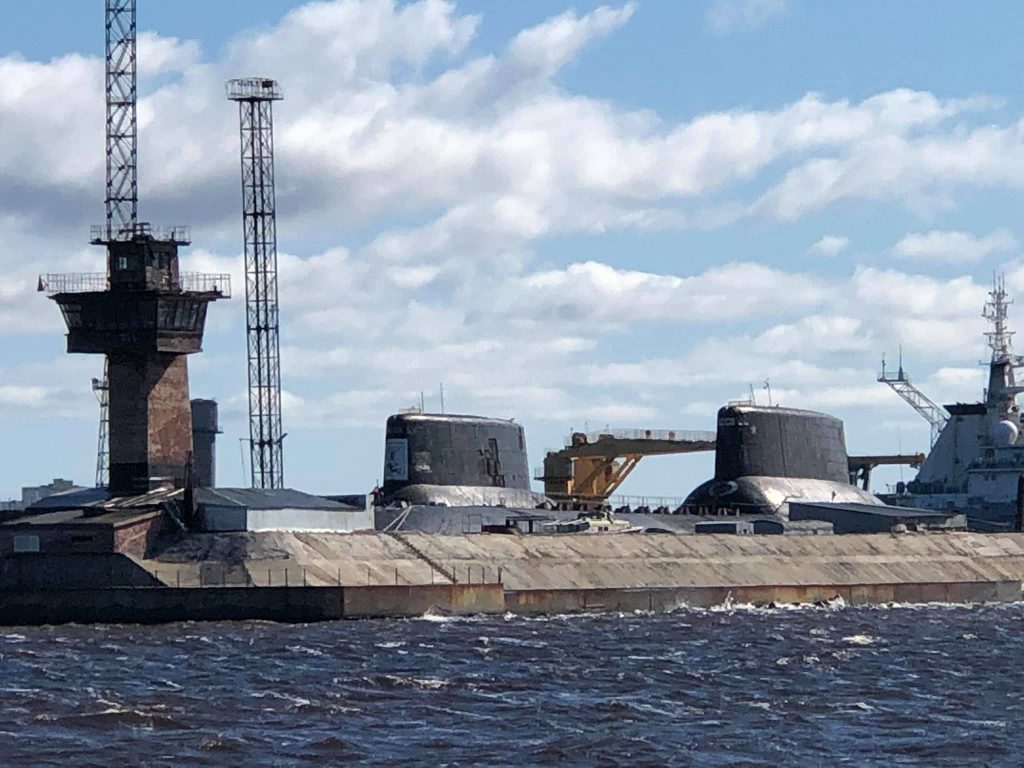
We rode to the city centre and stopped at the shop to buy some food. Suddenly a young fellow ran up to us and started asking where we came from, what kind of motorcycles we had, where we were going next and so on.
"What about going to the roof of this multi-storey house and look at the town from the height? I have a spyglass", he suddenly offered.
No need to ask us twice. Walking on the roof of a high-rise building in the city centre is already a small adventure! Andrew and his crew were doing roof repair work and when he saw us from the height, he went down. He is a motorbiker too and dreams of travelling. Such a good guy!
So far we haven't met a single bad person within two weeks of our journey! We must be very lucky! :)
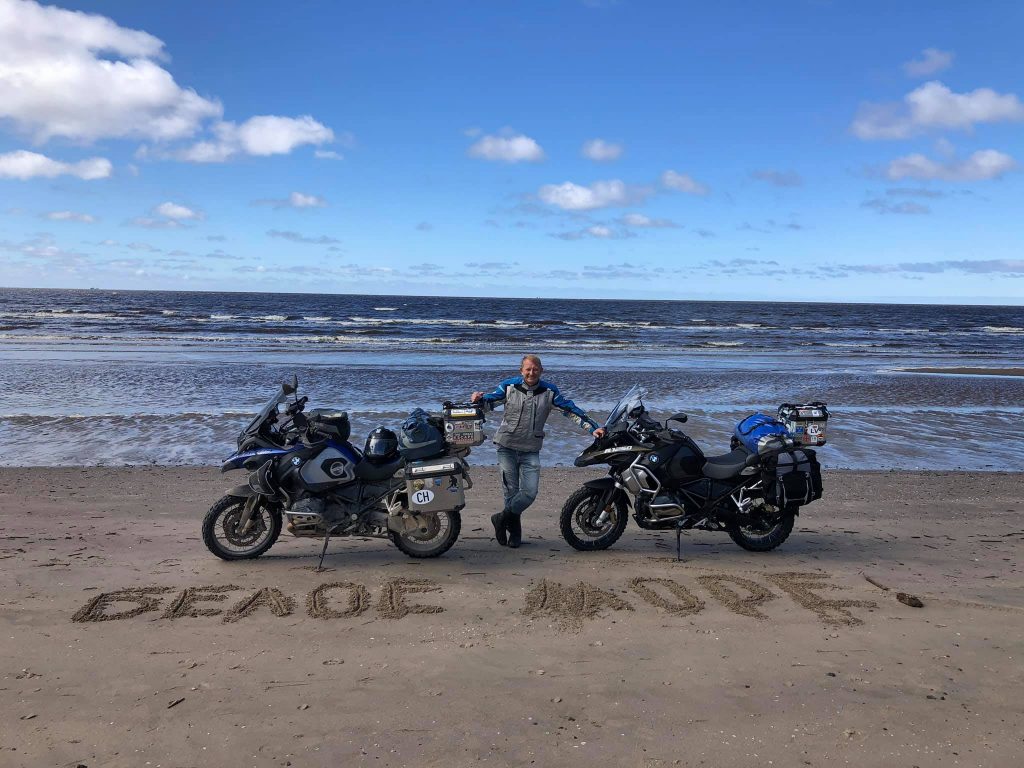
What is the most important thing in travelling? Of course it is an adventure! An unexpected and unpredictable one! There is no life without such moments.
Kiy island, Vorzogory.
I haven't managed to resurrect my motorbike, so I am waiting for the arrival of a car with a trailer for evacuation. But we don't waste our time.
In Onega I got acquainted with Andrew, a very interesting person, a local resident, an ethnic pomor, a hunter and an entrepreneur. We stayed in his beautiful guest house with all the conveniences and then Andrew suggested us going on an excursion to one of the islands in the White Sea and the village Vorzogory, which has a beautiful wooden temple on a high ugor in it.
We went by a small boat and half an hour later we reached Kiy island, a small piece of stone land a little more than 2 km long and up to 500 m wide, which is located 15 km from Onega. In general, there are hundreds of different islands in the White Sea: from the famous Solovetsky one to tiny ones in the shape of a rock or a stone protruding from the water.
Kiy island has an outstanding historical background, which is related to Patriarch Nikon (the one who carried out the reform of the Russian Orthodox church and generally played a huge role in the history of the country).
By his personal order and with his direct participation a monastery was built on the island in 1656. It has been preserved in good condition till nowadays. In addition, the island is interesting for its pine forest, sandy beach and a very beautiful bay.
Vorzogory.
One of the most fabulous and inaccessible villages of the Onega district is located on the high steep shore of the White Sea. On three sides it is surrounded by the sea, and on the fourth one by an impassable swamp.
It's not easy to get to it. First you have to reach an opposite shore by a small boat from Onega and then overcome 25 km along a ground road. But if you're lucky, the locals will give you a lift by UAZ or Lada Niva.
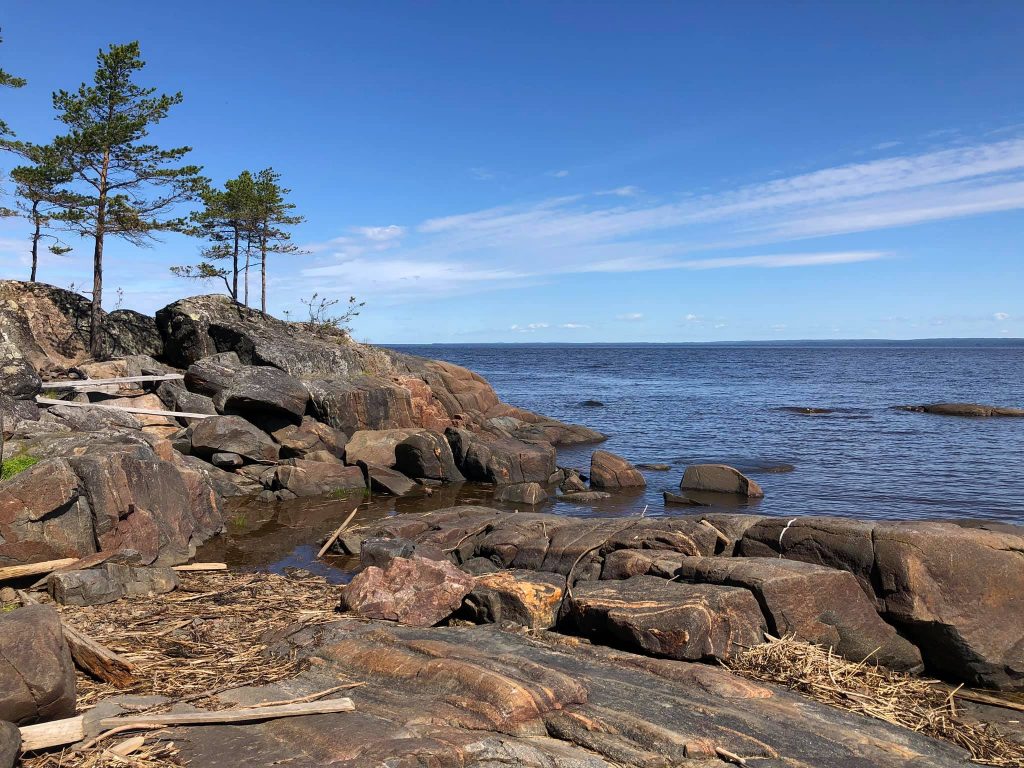
The houses in the village are different. There are old log huts built a century ago as well as new summer cottages. Despite the inaccessibility (or maybe vice versa, due to this circumstance) Vorzogory is quite a popular summer resort.
First, you can go to the forest to pick up some berries if you are not afraid of snakes and bears. Second, you can go down to the sandy beach and run barefoot along the wet sand at low tide. Third, you can just sit on a bench at the very edge of a 40-metre cliff, watching beluga whales hunt in the sea, seals play and fishermen set their nets.
The brightest attraction of Vorzogory is two wooden churches built in 1636 and in 1793 and a bell tower. The village itself was founded in the middle of the 16th century. This way, it is 450 years old!

A journey from the White Sea on four wheels.
Kargopol.
We continue our journey around the north of Russia. But already by car. In the morning the motorbike was loaded onto the trailer, we said goodbye to the kind-hearted hosts and left Onega. There are 1500 km ahead, but the most difficult thing is to get out of the Arkhangelsk region. It won't be easy to overcome hundreds of kilometers of broken ground roads, especially when you drag a heavy motorbike in a light trailer behind.
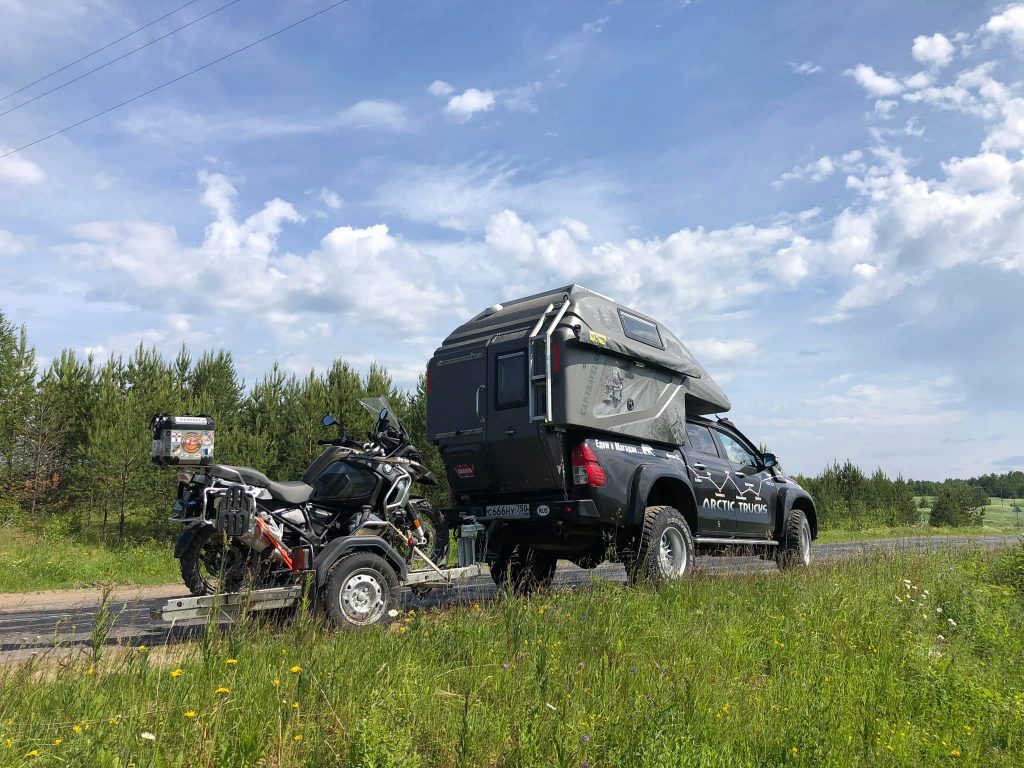
On the way back home we stopped in the village Piyala to admire the beautiful Church of the Ascension of Jesus built in 1651. We drove by small picturesque villages, having a stop from time to time to speak with the locals. They are really easy-going so if you say hello and ask them a simple question "How are you?", then you can be sure that you will be told in detail not only how they are doing, but also how everything is going in the whole village, and in the whole country. That's cool!
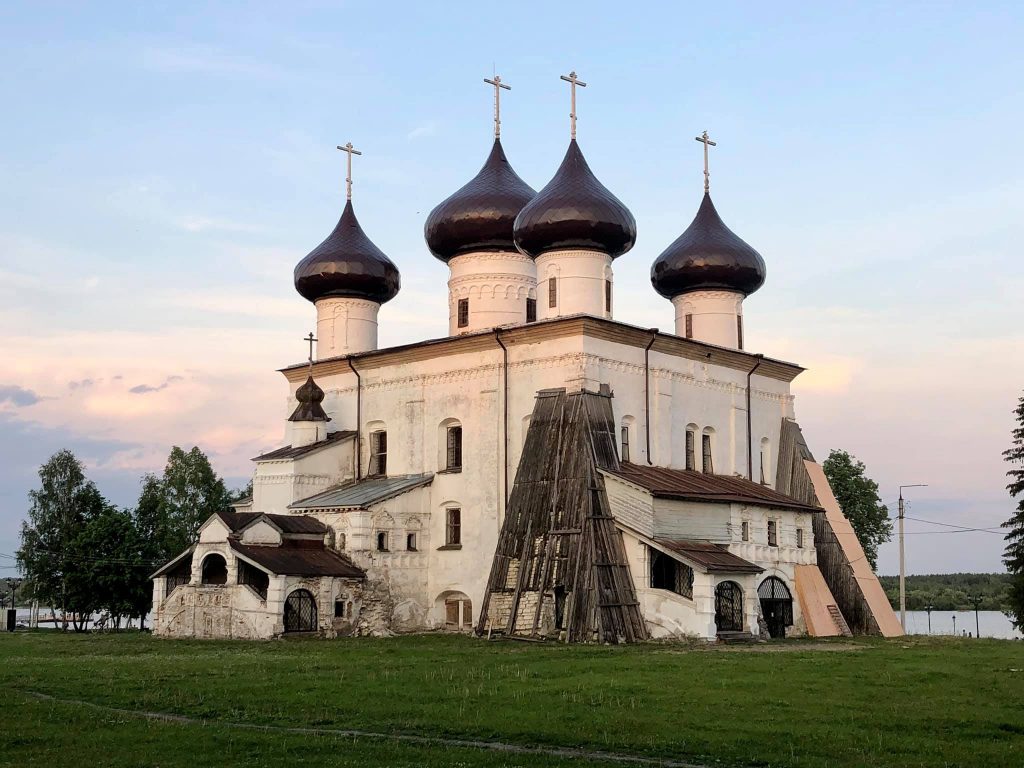
We drove the first hundred kilometers from Onega and faced the first problems. The ties with which the motorbike had been tied didn't withstand the load and tore, the trailer slowly began to fall apart too. We lost one taillight and a wing. The vehicle number had been lost even earlier. There appeared some cracks in the metal elements of the structure. Apparently, this construction is not suitable for our northern roads.
Somehow we got to Kargopol by evening. It's a small but very interesting town on the banks of the Onega.
We saw a beautiful embankment, a beautiful temple complex, a snow-white monastery, well-preserved old houses and streets, along which we were driving slowly, watching all these sights and carefully avoiding the pits on the asphalt road.
We definitely liked Kargopol! It's worth staying here for at least one day. Unfortunately, the museums were closed.
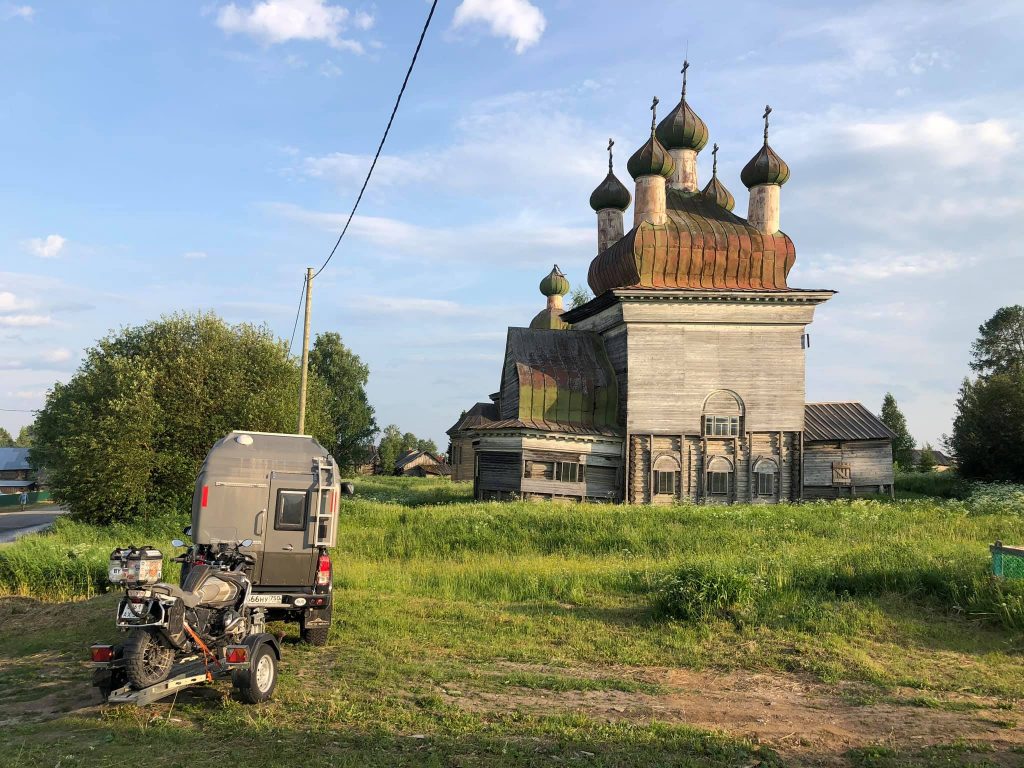
Another journey across the vast expanses of Russia came to an end. The North has amazed me and exceeded all my expectations. I've got the impression as if I went not by motorbike, but by time machine and returned to the past of 150 years ago.
I've experienced a minimum of civilization and a maximum of immersion into the history of the country. I've experienced 1500 kilometres of ground roads, majestic northern rivers, forests and impassable swamps, villages with rows of huge blackened wooden houses built in the 19th century, temples of amazing beauty and, the most important one, I've met a lot of wonderful people. At first glance, they are rude and unsmiling, but if you speak to them, you'll see great personality, sincerity and no deception in them.
Of course, two weeks are not enough to get fully immersed in the quiet life of the Russian north, breathe the forest scents, get soaked with the salty winds of the White Sea and reflect on the meaning of life, while sitting on the edge of the cliff of a small island. Two weeks are too little.
The North didn't want to let us go. On the way back my motorbike broke down completely.
It just stopped showing any signs of life. But thanks to this unpleasant case I was able to get to an amazing island, visit the fantastic places and meet interesting people. It took us three days to get home. The trailer fell apart completely, the motorbike tore the fastening straps and even tried to jump off the trailer while we were moving. That caused minor damages.
Clouds of mosquitoes, midges and huge gadflies intended to eat us alive while we were trying to twist the remains of the trailer and tie the stubborn motorbikey to it. It was more difficult to overcome those 300 kilometres off-road and 1200 km along the asphalt road in the latest three days than the whole way (4500 km) before.
This journey is over. But new routes are waiting for us! We're going to visit the Kola peninsula, Rybachy, the Barents Sea, the mountains of Dagestan, Chechnya and many other attractions soon.
 Cap-travel.ru
Cap-travel.ru